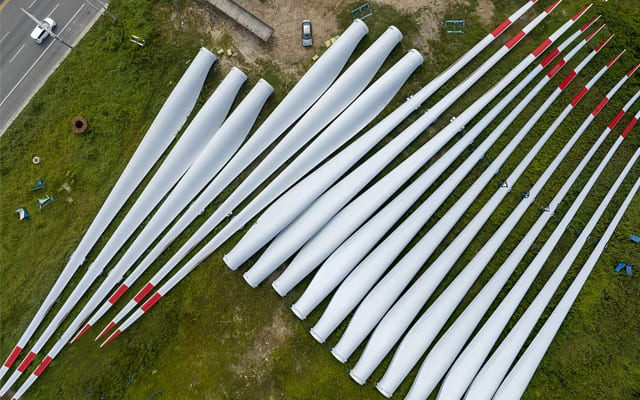At first glance, wind turbines seem to rotate slowly—especially the massive wind blades. Yet, these low-speed giants can generate megawatts of power reliably. Why is that? The answer lies in aerodynamic design, mechanical engineering, and power system integration. Let’s explore the science and logic behind the slow spin of wind turbine blades.
1. The Heart of the Wind System: Low-Speed Wind Blades + High-Speed Generator
1.1 Slower Wind Blades Are Designed to Maximize Energy Capture
Contrary to popular belief, wind blades are not designed to spin as fast as possible. Instead, their rotation speed is optimized for the Tip Speed Ratio (TSR)—the ratio of blade tip speed to wind speed.
TSR = Blade Tip Speed / Wind Speed
Horizontal-axis, three-blade turbines typically operate best at a TSR of 6 to 8. This allows the turbine to extract maximum energy from the wind—approaching the Betz limit of 59.3% theoretical efficiency.
✅ For example, with a TSR of 7 and a wind speed of 10 m/s, a blade tip may reach 60–70 m/s, even if the hub spins at only 20–30 RPM.
1.2 Gearboxes Convert Low-Speed Rotation into High-Speed Power
Although the rotor turns slowly, turbines use gearboxes to increase shaft speed dramatically. A typical example:
-
Blade RPM: 20
-
Gearbox ratio: 1:75
-
Generator speed: 20 × 75 = 1500 RPM
This 1500 RPM matches the standard speed for 50 Hz grid-connected generators, enabling stable and efficient electricity generation.
Modern gearless wind turbines (direct-drive systems) use large-diameter permanent magnet synchronous generators (PMSGs). These compensate for low rotor speed using advanced magnetic designs to maintain voltage and power output.
2. Why Can’t Wind Blades Spin Faster?
2.1 Structural Safety Comes First
Wind turbine blades are massive—often over 50 meters in length. If they spin too fast, the centrifugal force increases exponentially, putting extreme stress on the hubs, shafts, and tower structure. This raises the risk of material fatigue, cracks, or even catastrophic failure.
2.2 Aerodynamic Efficiency Drops at Higher Speeds
Wind is a low-density, low-speed energy source. If blade speed is too high, it causes aerodynamic stall—lift decreases, drag increases, and power output drops. Operating within the optimal TSR ensures maximum efficiency with minimal resistance.
2.3 Control Systems Require Stable, Predictable Rotation
Wind turbines rely on pitch control (blade angle adjustment) and yaw systems (tower rotation) to align with the wind. Slow-moving blades make these systems more responsive and precise, especially under changing wind conditions or during emergency braking.
3. Safety Design Requires Lower Blade Speeds
✅ Massive Inertia Demands Control
Due to their weight and size, fast-spinning wind blades would generate huge inertia. In case of emergency, stopping them becomes challenging. Slower blades reduce mechanical stress and allow safer operation in extreme weather.
✅ Better Emergency Braking in Storms
Fast rotation in turbulent wind makes turbines harder to control. Just like slowing down a car from 200 km/h is harder than from 20 km/h, it’s much easier and safer to brake slow-spinning blades during storms or wind gusts.
4. Slow Rotation, High Power: The Real Power of Large Wind Blades
The power output of a wind turbine is proportional to the cube of the wind speed and the swept area of the blades:
Power ∝ Swept Area × Wind Speed³
Larger wind blades sweep more air and capture more energy. Even at lower RPMs, they deliver hundreds of kilowatts or even megawatts of power efficiently.
✅Slow-Spinning Blades Are a Smart Design Choice
The slow rotation of wind blades is not a flaw—it’s a deliberate and intelligent design that ensures:
-
✅ Maximum aerodynamic efficiency
-
✅ Safe mechanical operation
-
✅ Precise control in changing wind conditions
-
✅ Effective power conversion via gearboxes or direct-drive systems

